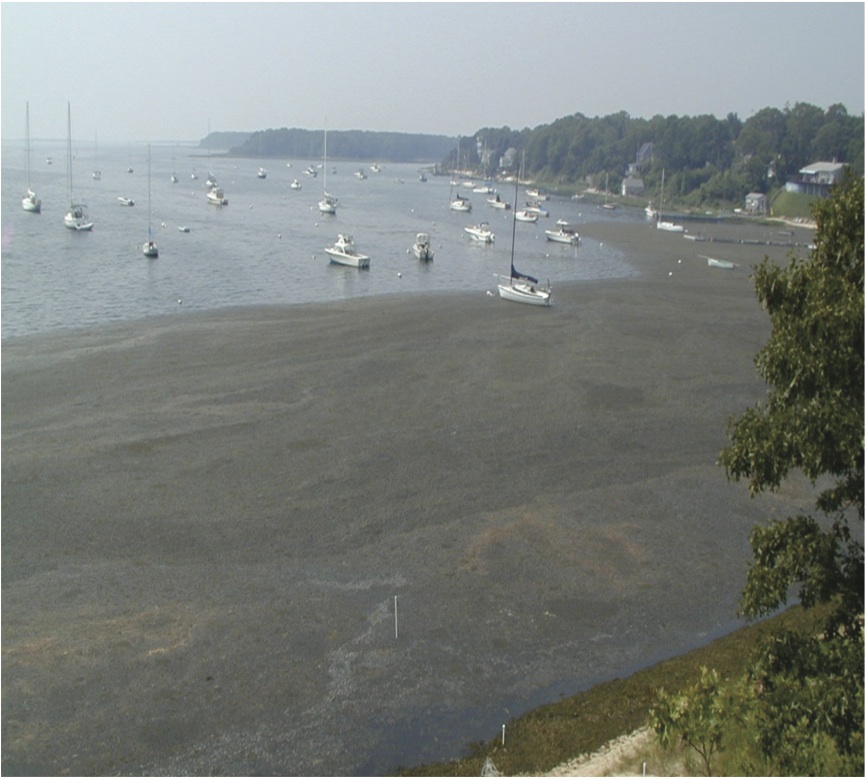Permeable Denitrifying Barriers
Aquatic systems around the globe are threatened by eutrophication resulting from the excess supply of nutrients derived on land, which can lead to algal blooms like those figured here. In coastal systems the nutrient that most frequently induced eutrophication is nitrogen, particularly the reduced nitrogen compounds ammonium and nitrate. These nutrients can be derived from multiple sources including atmospheric deposition, the application of fertilizers to agricultural crops, lawns and gardens, and recreational turf such as ball fields and golf courses, as well as via septic systems or sewerage outfalls. The microbially-mediated process of denitrification is one means of removing reduced nitrogen before it can cause eutrophication. Microorganisms that are able to denitrify remove reduced nitrogen in the form of nitrate because they are able to use nitrate as a respiratory substrate instead of oxygen. In the process, they convert nitrate to inert dinitrogen gas and return it to the atmosphere. Since most denitrifiers are heterotrophic (requiring an external source of carbon) they can become limited by the availability of carbon. Thus these organisms require three things, a supply of carbon, low oxygen conditions, and abundant nitrate. Providing all three of these conditions might be one way to promote the removal of fixed nitrogen and prevent eutrophication. Such a strategy is currently in place at the Waquoit Bay National Estuarine Research Reserve, located on Cape Cod, Massachusetts.
Two permeable reactive barriers were installed by the engineering firm Lombardo and Associates, which were designed to intercept groundwater flow and, by providing a carbon source for denitrifying bacteria, enhance rates of denitrification. Results from colleagues Joe Vallino and Ken Forman at the Marine Biological Laboratory show very large losses of nitrate as water moves from upgradient to downgradient of the barrier, suggesting that there are very active communities of denitrifiers populating the barrier substrate. With funding from MIT Sea Grant, we began investigating the community composition of the microbes living within, upgradient, and downgradient of the barrier to see how the barrier has altered the structure of the microbial community, in particular bacteria involved in nitrogen cycling and mercury cycling (Fig 2). Thus far our results show that the bacterial community composition is dramatically altered by the carbon supplied by the barrier, compared to adjacent aquifer soil with no barrier present (Hiller et al. 2015). Furthermore, the taxa that are present in the barrier are disproportionately found to be representatives of unusual and largely uncultured bacterial taxa belonging to the newly identified Candidate Phylum Radiation. We are doing additional work using flow through mesocosm experiments to characterize specifically how nitrogen and mercury cycling, and the genetic basis of these functions are affected by the presence of the barrier.
 |
 |
| Fig 1. Placement of the underground barriers have a dramatic effect on algae production as shown above. Green algae dominates the coast except where the barrier was placed (red). | Fig 2. Candidate phyla from reference, upgradient, and permeable reactive barrier |
Publications associated with this work to date:
Hiller, K. A., K. H. Foreman, D. Weisman, and J. L. Bowen. 2015. Permeable reactive barriers designed to mitigate eutrophication alter bacterial community composition and aquifer redox conditions. Applied and Environmental Microbiology 81: 7114-7124.